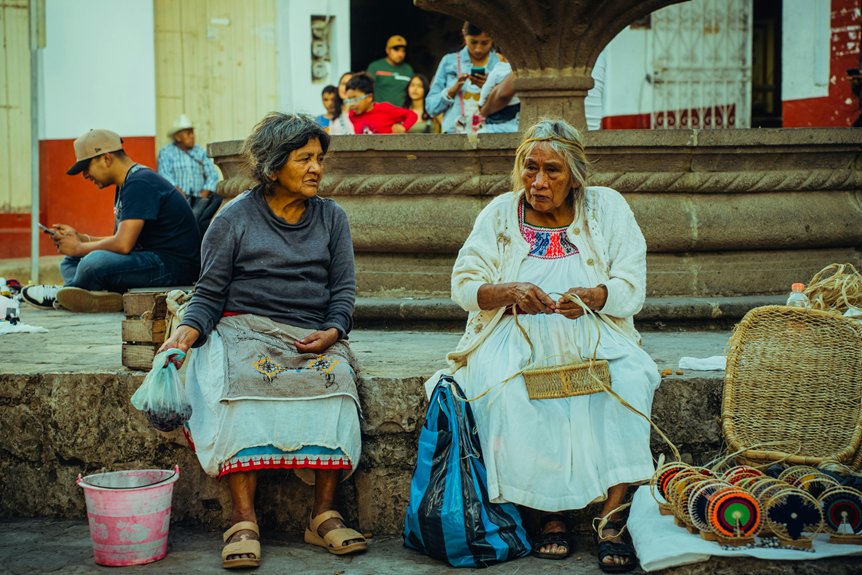Cyprian mountain village squares transport you into living architectural museums where stone structures and cobblestone pathways whisper centuries of cultural heritage. You’ll discover vibrant community spaces where generations connect through traditional festivals and shared experiences. These geometric landscapes blend Ottoman and Byzantine influences, featuring weathered stone facades and intricate design elements. Each square tells a story of resilience, inviting you to unravel more architectural secrets hidden within these timeless cultural landscapes.
Key Takeaways
- Cypriot mountain village squares showcase intricate stone architecture blending Byzantine and Ottoman design influences with local topographical adaptations.
- Central community spaces serve as cultural nexus points, hosting festivals, performances, and intergenerational social interactions that preserve local traditions.
- Traditional village squares feature compact geometric layouts with strategic building placements, emphasizing social hierarchy and community functionality.
- Architectural elements like red clay roof tiles, stone masonry, and wooden frameworks reflect the region’s distinctive environmental and cultural heritage.
- Restoration efforts prioritize maintaining historical authenticity while ensuring these village centers remain dynamic, living cultural landscapes with contemporary relevance.
Architectural Charm of Mountain Village Squares
While wandering through the mountain villages of Cyprus, you’ll immediately be struck by the architectural charm that defines these timeless squares. The village square architecture of Cyprus mountains reveals a stunning blend of stone buildings and intricate design, where every architectural element tells a story of cultural preservation.
You’ll notice how cobblestone streets wind elegantly around central spaces, creating harmonious landscapes that reflect generations of traditional craftsmanship. Stone structures with weathered facades stand as silent witnesses to the region’s rich heritage, their architectural integrity maintained through careful restoration and respect for historical techniques.
The squares aren’t merely physical spaces but living museums of Cypriot architectural expression. Churches and monasteries anchor these environments, their architectural presence serving as focal points that connect community, spirituality, and spatial design. Each stone, each carefully placed architectural element speaks to the mountain villages’ commitment to maintaining their unique cultural identity and architectural legacy.
Cultural Significance of Central Community Spaces
Beyond the architectural beauty of mountain village squares, these spaces pulse with social importance, embodying the heart of Cypriot community life. You’ll find these squares serving as dynamic stages where generations connect, traditions breathe, and cultural identity flourishes.
When you walk through these central spaces, you’ll witness more than physical infrastructure-you’re experiencing living heritage. Festivals, music performances, and seasonal celebrations transform these squares into vibrant platforms where community narratives unfold. Local residents gather to share stories, exchange news, and maintain intricate social networks that have sustained mountain villages for centuries.
The square isn’t just a location; it’s a communal heartbeat. Young and old converge here, bridging generational gaps through shared experiences. Traditional dances, regional cuisines, and handcrafted goods become conduits for cultural preservation. Each interaction reinforces the community’s collective memory, ensuring that Cyprus’ rich mountain village traditions continue to thrive and evolve.
Historical Evolution of Village Square Design
As Cypriot mountain villages developed over centuries, their central squares emerged as dynamic architectural reflections of changing social and cultural landscapes. You’ll find that early designs were intimately tied to practical community needs, with spaces initially serving multiple functions like gathering, trading, and hosting communal events.
Traditional square layouts gradually transformed from simple, functional areas to more structured architectural environments. You’ll notice how Ottoman and Byzantine influences shaped geometric arrangements, introducing stone-paved surfaces and strategically positioned buildings like churches and coffeehouses. These spaces weren’t just physical locations but symbolic representations of village identity and social hierarchy.
Traditional Materials and Building Techniques
Because stone speaks the silent language of Cypriot mountain heritage, traditional building techniques reveal a profound connection between landscape and human craftsmanship. You’ll discover how local builders masterfully integrated natural resources like stone, clay, and timber into their architectural designs, creating structures that seamlessly blend with the rugged mountainous terrain.
Stone masonry forms the foundational narrative of these villages, where skilled artisans carefully selected and fitted local stones to construct resilient walls and foundations. Wooden beams strategically supported architectural frameworks, while red clay roof tiles crowned buildings with a distinctive regional aesthetic. The compact village layouts, with their narrow winding streets, demonstrate an intuitive understanding of the landscape’s topographical challenges.
Architectural elements like courtyards and covered walkways weren’t merely functional but served as social spaces that fostered community interaction. By preserving these traditional building methods, you’re witnessing a living cultural legacy that communicates the ingenuity of Cypriot mountain communities.
Social Dynamics of Mountain Village Gathering Places
The stone walls that once sheltered mountain craftsmen now frame vibrant social landscapes where community pulses through ancient village squares. You’ll discover these spaces are more than mere physical locations-they’re living, breathing cultural theaters where generations converge and traditions breathe.
When you walk into a Cypriot mountain village square, you’ll witness a choreography of social interaction. Elders share local gossip over coffee, artisans demonstrate traditional crafts, and families gather during seasonal festivals. The cobblestone pathways become storytelling venues, where each stone seems to whisper generations of shared experiences.
These squares aren’t just architectural spaces; they’re social infrastructures preserving community memory. Here, casual conversations weave intricate social networks, and cultural practices are transmitted through spontaneous interactions. You’ll sense how these gathering places transcend mere physical geography, becoming profound expressions of collective identity, resilience, and continuity in Cyprus’s mountain communities.
Preservation and Restoration of Historic Village Centers
How do you breathe life into stone-built memories? By carefully preserving the architectural soul of Cyprus’s mountain villages. You’ll find meticulous restoration efforts transforming historic settlements like Fikardou, where traditional woodwork and folk architecture have been honored with international recognition, including the prestigious Europa Nostra award.
In villages like Pano Lefkara and Lofou, you’ll witness a delicate balance between conservation and revitalization. Old stone houses are lovingly restored, cobbled streets are maintained, and adaptive reuse transforms historic buildings like old primary schools into living cultural spaces. These efforts aren’t just about maintaining structures; they’re about preserving community identity.
You’ll notice how new elements-cafes, wine bars, and shops-are thoughtfully integrated alongside traditional architecture. The result is a vibrant landscape that respects historical integrity while providing contemporary functionality, ensuring these mountain villages remain dynamic, authentic spaces that connect past and present.
Village Squares as Living Cultural Landscapes
Wandering through Cyprus’s mountain village squares, you’ll discover more than mere architectural spaces-these are living, breathing cultural landscapes that pulse with generations of collective memory. Each cobblestoned corner and stone-crafted building tells a story of community resilience and cultural continuity.
You’ll find these squares aren’t static museum pieces, but dynamic environments where tradition thrives. Historic religious structures anchor community identity, while local markets and festivals animate the space with contemporary rhythms. Traditional crafts, artisan shops, and quaint cafes intermingle, creating a rich tapestry of social interaction.
These squares represent more than geographical centers; they’re repositories of shared heritage. As Cypriot authorities prioritize their preservation, they’re ensuring these spaces remain vibrant cultural hubs. Every conversation, market transaction, and communal gathering reinforces the deep-rooted connections between people, place, and history-transforming village squares into living archives of Cypriot identity.
Frequently Asked Questions
What Is the Most Beautiful Mountain Village in Cyprus?
You’ll find beauty is subjective, but Omodos captures the essence of Cypriot mountain charm. Its cobblestone streets wind through historic stone houses, and the central monastery whispers centuries of cultural heritage. You’ll be enchanted by the traditional craft shops, the intimate village square, and the sense of timeless authenticity that makes Omodos feel like a living museum of Cypriot mountain life.
What Is the Most Beautiful Old Town in Cyprus?
You’ll find Pano Lefkara capturing the essence of Cyprus’s historic charm. Its traditional architecture, intricate lace-making, and silver craftsmanship tell a rich cultural story. The village’s well-preserved stone houses, narrow winding streets, and timeless atmosphere transport you to a bygone era. Its UNESCO-recognized heritage and artisanal traditions make it not just a beautiful old town, but a living museum of Cypriot identity.
What Is the Traditional Cypriot Village Near Paphos?
Step back in time, and you’ll find Fikardou Village nestled near Paphos, a hidden gem frozen in medieval splendor. You’ll discover a practically deserted settlement that’s bursting with authenticity, where traditional brick houses with red-tiled roofs whisper stories of rural Cypriot life. Two preserved museums showcase local artifacts, and the village’s untouched character earned it the Europa Nostra award, making it a must-visit cultural treasure.
What Is the Difference Between Omodos and Lefkara?
When you explore Omodos and Lefkara, you’ll notice distinct differences. Omodos, nestled in the Troodos Mountains, feels more like a working village with rugged stone houses, while Lefkara has transformed into a tourist destination with white-washed buildings and artisan shops. You’ll find Omodos maintains a raw, traditional atmosphere, whereas Lefkara offers a curated cultural experience through its renowned lace-making and silversmith crafts.
Conclusion
You’ve wandered through Cyprus’s mountain village squares, witnessing centuries of cultural heartbeats etched in stone and shared stories. These extraordinary spaces aren’t just geometric arrangements, but living archives of community memory and architectural resilience. They’ve survived generations, preserving traditional social rhythms and architectural wisdom that pulse more powerfully than a thousand historical textbooks. Your journey reveals these squares as timeless cultural landscapes.

Meet Natalie, who has lived on Cyprus for the last 10 years. She loves exploring the beautiful nature of the island, like quiet forests and untouched beaches. Natalie has lots of cool experiences to share. Join her as she talks about her adventures in Cyprus.

